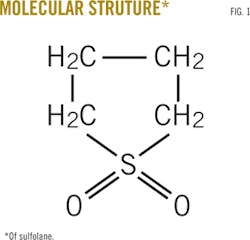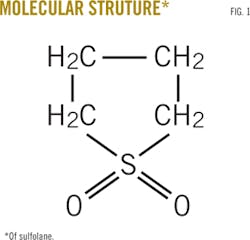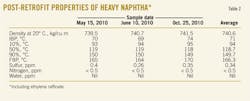Low-cost revamp enhances feedstock profitability for Chinese integrated complex
Zhifang Tang
Wusheng Huang
Feng Zhou
Hongfei Ji
Dajun Xiao
Keng H. Chung
Liaoning Huajin Tongda Chemicals Co. Ltd.
Qiang Wei
China University of Petroleum
Beijing
In 2010, Liaoning Huajin Tongda Chemicals Co. Ltd. (Huajin), a subsidiary of China North Industries Group Corp. (Norinco), completed a series of retrofits and process flow improvements to maximize the feedstock value of raffinate oil derived from ethylene-cracking at its Panjin integrated refining and petrochemical complex in Liaoning Province, China.
Designed to prepare ethylene raffinate into a suitable reforming feedstock, the project required implementation of a desulfurization program, which was accomplished by rerouting raffinate from Huajin's petrochemical plant to the product fractionation system of the refinery's heavy gas oil hydrocracking process where the ethylene raffinate was heated to thermally decompose sulfur compounds present in the raffinate.
The low-capital improvements Huajin instituted to transform its ethylene raffinate production into appropriate feedstock for reforming operations at its 8 million-tonnes/year (tpy) refinery have led to sharp profit gains for the complex.
Background
Ethylene raffinate oil is a byproduct of the ethylene-cracking process at Huajin's petrochemical plant, which produces about 700,000 tpy of ethylene.
Before the commercial retrofitting of Huajin's complex in April 2010, ethylene raffinate from the petrochemical plant's aromatics extraction unit was recycled and used as feedstock for ethylene cracking, which is a normal practice in most standalone petrochemical plants.
Steadily rising demand for transportation fuels and ethylene in China, however, prompted Huajin to evaluate ways it could reduce feedstock costs by capitalizing on byproducts readily available from its own integrated operations.
Typical ethylene raffinate contains less than 35 wt % paraffins and more than 60 wt % cycloparaffins. As a result, it is not an ideal feedstock for ethylene cracking, which has a low yield of diene.
Because raffinate derived from ethylene cracking has a high cycloalkanes content (more than 60 wt %), Huajin determined it potentially could serve as a suitable-and profitable-feedstock for catalytic reforming at the complex.
Before this could occur, however, the ethylene-derived raffinate would need to undergo processes for the removal of sulfur and other impurities, as it contains a high amount of sulfur compounds (primarily sulfolane) due to residual solvent entrained from the aromatic extraction unit of the ethylene cracking unit. These compounds are detrimental to catalytic reforming, causing catalyst poisoning and deactivation.
Desulfurization
In an integrated refining and petrochemical complex, ethylene raffinate commonly is blended with naphtha streams recovered from gas oil hydrocracking. This blended stream then can be used as feedstock for reforming processes to produce high-octane gasoline or various aromatics. Li and Song reported that a commercially obtained ethylene raffinate containing 58.8 wt % cycloalkanes could be blended with a hydrocracked naphtha and used as reforming feedstock to produce a high yield of benzene.1
At the Huajin petrochemical plant, the ethylene raffinate oil contains 4 ppm sulfolane with a sulfur content of 1 ppm. Feedstock specifications for the catalytic reforming process, however, require less than 0.5 ppm sulfur. Left untreated, then, Huajin's ethylene raffinate could not be used as reforming feedstock.
A colorless liquid, sulfolane (Fig. 1) is used as solvent in the aromatic extraction unit of the ethylene cracking process. Its presence in ethylene raffinate oil arises from residual solvent. With a melting point of 27.5° C. and flashpoint temperature of 165° C., sulfolane decomposes readily at more than 220° C. into black polymeric substances and sulfur dioxide.
Since the reforming process at Huajin's refinery is not equipped with a feedstock pretreatment unit, desulfurized heavy naphtha from the naphtha fractionation unit of the plant's heavy gas oil hydrocracking process typically served as reforming feedstock.
After evaluating possible courses of action, Huajin determined that, because of its high-sulfur content, raffinate from the petrochemical plant's ethylene-cracking operations could not be treated in the refinery's reforming process without a prehydrogenation unit.2
The proposed low-cost method for desulfurization of ethylene raffinate oil was to take advantage of sulfolane's decomposition characteristics at high temperatures by routing raffinate supplies into the fractionation unit (operating at 350° C.) of the refinery's heavy gas oil hydrocracking process.
Retrofitting
After a situation appraisal, Huajin identified a few available process options to remove sulfolane from its ethylene raffinate byproduct, which included physical removal, as well as thermal and catalytic desulfurization.
Huajin selected thermal desulfurization because of its technical simplicity, minimum downtime, and cost effectiveness.
The retrofitting project, which was carried out during the period of a regularly scheduled turnaround, involved the installation of a 1,000-cu m storage tank and pump for ethylene raffinate.
Fig. 2 shows the retrofitting made to the product fractionation system of Huajin refinery's heavy gas oil hydrocracking process to enable the desulfurization of ethylene raffinate.
Commercial implementation
Since completion of retrofitting activities, ethylene raffinate from Huajin's petrochemical plant has been rerouted to the product fractionation system of the adjoining refinery's heavy gas oil hydrocracking process to serve as feedstock for the catalytic reforming operations, as described below.
After arriving to the refinery's 1,000-cu m storage tank from Huajin's petrochemical site, ethylene raffinate is pumped at 3-5 tonnes/hr (tph) to the fractionator surge tank, where it is blended at 180 tph with 260° C., steam-stripped hydrocracking product, which consists of light-liquid product stream from the refinery's heavy gas oil hydrocracker.
This mixture then is heated to 350° C. in a furnace and fed to the fractionation tower. Sulfolane present in the ethylene raffinate undergoes thermal decomposition, producing light hydrocarbons and sulfur compounds (sulfur dioxide and hydrogen sulfide).
The overhead stream of the fractionation tower-made up of naphtha and sulfur compounds (sulfur dioxide and hydrogen sulfide)-is routed to the naphtha fractionation unit.
A fraction of the overhead stream is cooled with a heat exchanger and then sent to a reflux accumulator, after which it is recycled back to the top section of fractionation tower.
Jet fuel supplies are recovered from the fractionation tower's midsection and pumped to a product tank.
The fractionator bottoms, consisting of hydrocracked heavy fractions, are recovered for use as refinery blending stock.
Light naphtha and sulfur compounds are recovered from the naphtha fractionation tower's top section for use as feedstock in the petrochemical plant's ethylene cracking process, in which the catalyst used benefits from the small amount of sulfur compounds present in the feed.
From the bottom section of the naphtha fractionation tower, heavy naphtha containing thermally treated ethylene raffinate is recovered and also used as reforming feedstock at the refinery.
Process performance
Since the 2010 retrofitting and process improvements, the quality of heavy naphtha feedstock has been stable, which has enabled Huajin refinery to maintain smooth catalytic reforming operations.
While concentrations of sulfur at 1.07 ppm and sulfolane at 4.91 ppm exceed reforming feedstock concentrations, the high cycloalkanes content of Huajin's ethylene raffinate has proven beneficial for its use as feed to reforming operations.
Table 1 shows the properties of ethylene raffinate from the ethylene-cracking unit at Huajin's petrochemical plant.
Since the retrofitted commercial plant entered operations on May 15, 2010, testing results indicate that the sulfur content of heavy naphtha has remained relatively consistent at less than 0.5 ppm, which meets the reforming feedstock requirement.
Table 2 shows the properties of a sampling of heavy naphtha collected from Huajin's naphtha fractionator.
Recommendations
In the petrochemical plant, the sulfur content of ethylene raffinate derived from ethylene cracking should be kept at less than 3 ppm to prevent damage to the hydrocracking process, which could result in increased sulfur content of heavy naphtha.
For ethylene raffinate with high-sulfur content, the feed rate to the hydrocracking fractionation system should be reduced and the blending amount limited to less than 5 tph.
For Huajin's project, the maximum-designed blending amount was set at 6 tpy, with the yield of ethylene raffinate remaining typically lower than that maximum.
Economic benefits
In May 2010, ethylene raffinate produced at Huajin's complex could be sold as chemical-grade naphtha for $867/tonne. During the same period, petroleum-derived benzene, toluene, and xylene were priced at $1,167/tonne, $1,083/tonne, and $1,125/tonne, respectively.
Assuming that the aromatics yield of ethylene raffinate is 70 wt % with the remaining 30 wt % used as feedstock for ethylene cracking, the additional revenue derived from ethylene raffinate was $167/tonne.
After subtraction of a process operating cost of $33/tonne, the net profit for using ethylene raffinate as feed for catalytic reforming instead of ethylene cracking was $134/tonne. For Huajin's integrated complex, which maintains an ethylene raffinate production rate of 30,000 tpy, the net profit in 2010 was $4 million.
Over the past 4 years, Huajin's net profit from the retrofitting project has varied slightly between $4 million and $4.5 million/year due to minor relative price variations of petroleum products.
References
1. Li, B., and Song, H., "Process Optimization of Hydroracking-Derived Naphtha and Raffinate Oil Used as Reforming Feedstock," Friend of Chemical Industry (in Chinese), No. 11, 2006, pp. 21-22.
2. Xu, C., "Catalytic Reforming Process & Engineering," Beijing: China Petrochemical Press, 2006, pp. 131-133.
The authors
Zhifang Tang ([email protected]) serves as chief engineer for Liaoning Huajin Tongda Chemicals Co. Ltd. and also is on the company's board of directors. With more than 30 years of experience in refining and petrochemicals, he previously held senior technical and executive positions with PetroChina Fushun Petrochemical Co. Ltd. He holds a petrochemical engineering degree from Fushun Petroleum Institute, Fushun, China.
Wusheng Huang ([email protected] ) is the refinery manager of Liaoning Huajin Tongda Chemicals Co. Ltd. He holds a degree in chemical technology from Shenyang Institute of Chemical Technology, Shenyang, China, and has more than 20 years of refining experience.
Feng Zhou ([email protected]) serves as petrochemical plant manager for Liaoning Huajin Tongda Chemicals Co. Ltd. He holds a degree in chemical technology from Shenyang Institute of Chemical Technology, Shenyang, China. Zhou has more than 20 years of experience in ethylene production.
Hongfei Ji ([email protected]) is deputy director of refinery technical services for Liaoning Huajin Tongda Chemicals Co. Ltd. He holds a degree in petroleum refining from Fushun Petroleum Institute, Fushun, China. Ji has more than 10 years of refinery experience.
Dajun Xiao ([email protected]) serves as deputy director of petrochemical plant technical services for Liaoning Huajin Tongda Chemicals Co. Ltd. He holds a degree in chemical engineering graduate from Shenyang Institute of Chemical Technology, Shenyang, China. Xiao has more than 10 years of experience in ethylene production.
Qian Wei ([email protected]) is a research scientist at China University of Petroleum, Beijing, China, and has been a visiting scholar at Natural Resources Canada's CANMET Western Research center at Devon, south of Edmonton, Alta. He holds a BS in chemical engineering from Shandong University, Shandong, China, as well as an MS and PhD, both in chemical engineering, from China University of Petroleum, Beijing.
Keng H. Chung ([email protected]) serves as refinery advisor for Liaoning Huajin Tongda Chemicals Co. Ltd. He also acts as a process troubleshooting expert for petroleum operations and actively is involved in developing sustainable heavy oil technologies. Chung holds a BS and MS in chemical engineering from Queen's University, Kingston, Ont., and a PhD in chemical and petroleum engineering from the University of Calgary. He is a registered professional engineer in Alberta, Canada.




